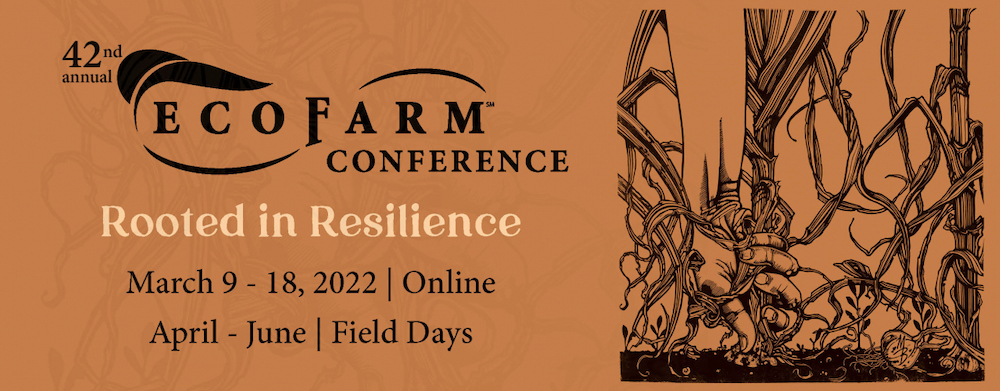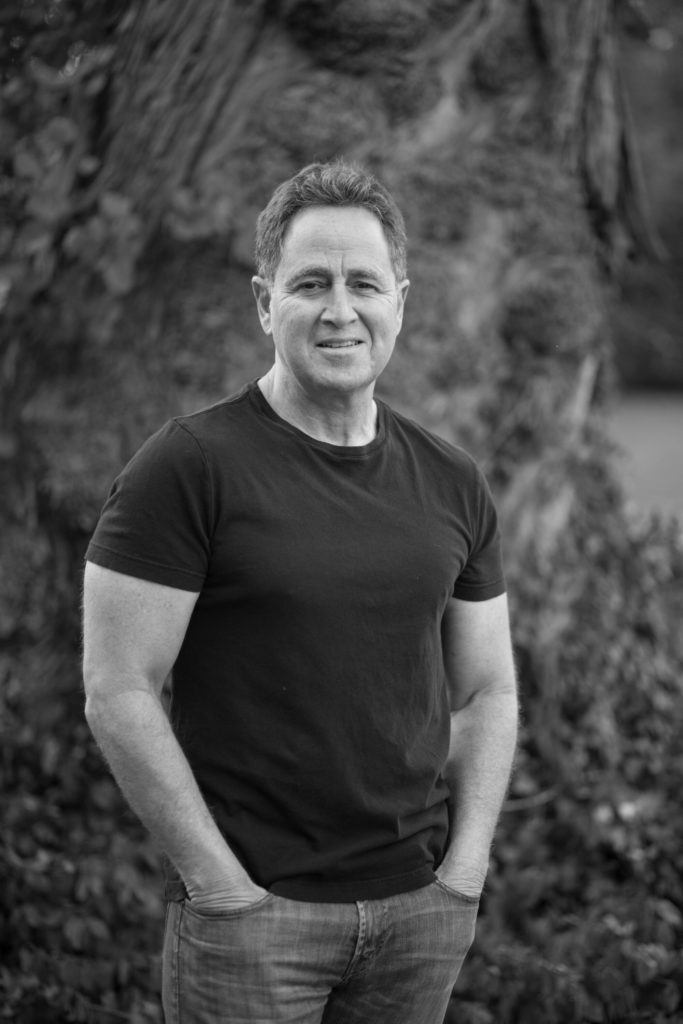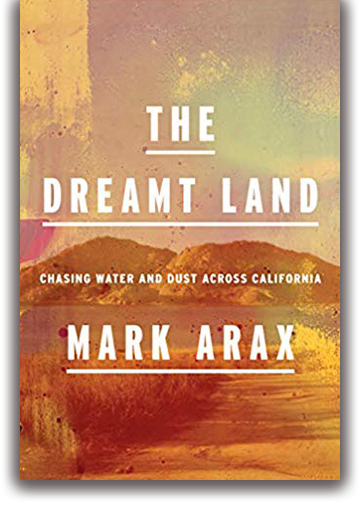March 1, 2022 – Tutorials on indigenous agriculture. Talks on the power of mushroom-driven “MycoRenewal.” Keynotes on harrowing crises and heady solutions like “Farmworkers on the Forefront: Connecting Our Struggles for Liberation” and “The 21st Century Food System We Deserve.”
Workshops that dive deeply into plans for the next Farm Bill, organic soil health on the Central Coast and the 2022 National Organic Research Agenda.
A town hall loaded with experts on healing and reconciliation by way of growing food.
Multiple pioneers of organic agricultural assembling for one epic panel.
There probably is a word for benevolently overwhelmed in German. In English, at least for those inclined toward organic ag, the word is…EcoFarm.
So much education, connection and content proliferate that a comprehensive preview proves impossible, or at least ill-advised.
Instead Edible will furnish insight into some COVID-planning plot twists, programming highlights, and a conversation with one of the main draws from a stacked keynote lineup.

As I wrote with “EcoFarm 2021 Reimagines and Inspires”: A funny thing happened when EcoFarm went virtual, and participants were confined to their own private quarters and had to beam into 2021’s conference remotely. (EcoFarm 2020 happened in its annual month, January, and generated its typical groundswell of compelling takeaways.)
In some ways, the far-reaching summit reached farther.
Don’t get me wrong. I’ve attended EcoFarm for a decade and love nothing more than in-person interactions at the expo, tastings, meals and mixers, in particular because of the spontaneous encounters with organic pioneers, colleagues and new friends.
But there is something to be said for democratizing access limited to those with the budget to travel and lodge in Pacific Grove to a wider throng, and for the ease of jumping from compelling session to session without sprinting across the Asilomar campus.
Typically a handful of nations are represented; in 2021 they numbered around 20. The energy to seize upon the opportunities of a new administration was palpable, even from a distance. I reported 16 different takeaways—involving everything corporate food accountability to James Beard Award-winning vegan Southern food—but could’ve listed 50.
Messaging ahead of the January 2022 conference emphasized in-person. But with the rising Omicron variant, it made sense to postpone and go online again. EcoFarm 2022 will run March 9-18, its longest duration ever.
The first week (March 9-13) will feature pre-conference events, films, and special events including Rooted in Your Own Resilience and EcoFarm’s annual Seed Swap.
The second week (March 14-18) will feature more than 30 workshops, the keynote speakers, awards, and a memorial, along with time for discussion and affinity groups to gather.
More good news: EcoFarm organizers have had a year to evolve the virtual version, and aim to continue to extend it to wider audiences.
“It totally did open up new opportunities for folks, for sure,” communications director Deborah Yashar says, “I’m happy we have some experience with [virtual] now. We’ll be better at it this time around. We have so much to present.”
That translates to a new EcoFarm online community that will premiere at the conference and allow for year-round access to EcoFarm content. https://eco-farm.org/conference/2022/ecofarm-community
“For years I’ve heard people say, ‘The conference is over…now what?! We have to wait a whole year again?’” Yashar says. “Not anymore.”
As part of the platform, EcoFarm will soon offer an archive of conference recordings, both visual and audio, a deep trove of organic farming and food knowledge.
Expanded access will also include keynotes translated to Spanish and seven workshops conducted en Español too.

Mark Arax’s accomplishments as a journalist and an author can be benevolently overwhelming themselves.
Across a decorated career as a longtime L.A. Times reporter and contributor to the likes of The Atlantic, he reveals an uncanny balance between bulldog investigative reporter and poetic storyteller—and between nose-to-the-soil citizen scientist and big-picture philosopher.
He’s also deeply connected to his native San Joaquin Valley, which he appropriately calls the world’s biggest agricultural experiment, and where he tends a modest organic stone fruit orchard in his backyard. This connection makes his artful book on the valley’s water crisis, The Dreamt Land: Chasing Water and Dust Across California, that much more personal and powerful.
At EcoFarm, he’ll present the March 15 keynote “Water, Land and Power in the Central Valley: Towards an Ecologically Sound and Just Agriculture.”
Edible: “Rooted in Resilience” is the theme of EcoFarm 2022. Getting into your book and learning how we’re tapping ancient water that took eons to accumulate, resilience seems out of reach. Is it?

Arax: Resilience is a tough place to reach. Why? Because we begin each growing season with a huge uncertainty. How much snowmelt is going to flow down our rivers? How far down has our aquifer dropped? In California, we don’t need global climate change to experience climate change. It’s our reality. The “average year” here is a myth. One year our rivers and streams produce 30 million acre feet of water; the next year they might produce 200 million acre feet. The year we hit average, 72.5, is an aberration, a lie we tell ourselves.
The state and federal water systems that govern so much of our farm life base their models on an average we never hit. That’s why we’re pumping the hell out of the groundwater, that’s why the ground is sinking. What we’re seeing now is global climate change hitching on the back of California’s own inherent wild swings of nature. We’re seeing a kind of havoc—lack of chill, mild winters, wildfires extending throughout the year, record droughts—we’ve never seen.
Eight of the last 10 years have been drought years. And yet look at San Joaquin Valley, the most intensive agricultural experiment the world has ever seen. Given the scarcity of snowmelt, one would logically think that the farmers here would be reducing their water use and agriculture’s footprint. Instead, they planted 660,000 more acres of permanent trees—almonds, pistachios and mandarins–during this drought. It speaks to a communal madness.
When did that madness begin? Is it part of California’s DNA?
I think it is. Look at how California began. It began with genocide. And then once the Americans seized California from Mexico, the state was shot out of a cannon by the Gold Rush. That model of extraction continues with us today. We’re sprawling farmland into places where it should never be.
That sprawl model of agriculture is mirrored by the sprawl model of suburbia. That’s why we have 10 million Californians today living in the path of wildfire, one fourth of our population.
It’s so deeply ingrained in who we are. The title of my book The Dreamt Land is not by accident. We dreamed this place and now the dream is coming undone. We’ve reached this limit line. To me, organic farming, and its precepts and ideals, are more urgent and vital today than ever.
That’s our way out.
Without surrendering state secrets from your keynote, what are some steps to take “Towards an Ecologically Sound and Just Agriculture.”
Getting rid of mega-dairies in California is one. They pollute groundwater, they pollute the air, they don’t employ many people and they rely on alfalfa and silage, which are water guzzlers. Our water and soil are too valuable to be growing a million acres of alfalfa. Can we find the courage to send the mega-dairies to Colorado where the cows will be happier? And keep just our smaller dairies?
Two, implement the [state] Sustainable Groundwater Management Act the way it was intended [to regulate groundwater extraction]. The SGMA law gives farmers 25 years to put it into effect. That’s way too long. The legislature needs to speed that up.
There’s a piece I wrote for The Atlantic about a gentleman known as “The Well Fixer.” It reads almost like an allegory. He’s a brave dude who challenged his neighbors in farm country about the incredible amounts of water they were pumping out of the earth in Madera County. The overdraft there is alarming. He told me: “Drought on top of drought. Climate change on top of drought. And our response is always the same. Plant more almonds and pistachios. Plant more housing tracts on farmland. But the river isn’t the same. The aquifer isn’t the same.”
He probably lost some business, but felt, “I can’t keep what I’m doing and not speak my truth.”
Three, reducing the footprint of agriculture from 6 to 4.5 million acres [in San Joaquin Valley] is another. It’s the only way we’re going to make sure we’re not extracting more groundwater than we’re recharging. Are things going to get so dire that we need to build desalination plants?
The questions raised in the book that seemed radical or extreme when it came out in 2019 are now questions a lot more people are asking themselves. Climate change has opened up possibilities for us to conceive solutions we didn’t dare conceive before. The state might now tell a county you can’t approve that project in the wildland-urban interface. All land use decisions used to reside with the locals. I can see the state saying, like it has done with SGMA, “We’re going to regulate the growth of suburbia.”
What would be helpful for lay people to understand about “paper water”?
As farmers and developers push for a market solution for some of this, they’re engaging in some deals that make sense and some deals that are hocus pocus.
An example of each: Water-rich farmers in northern Sacramento Valley are growing a surplus crop, rice, and getting pretty modest returns for it. They’re good family farmers and they’re finding a way to send some of their tailwater for wildlife. To grow fish. Fresno farmers reliant on federal water for pistachios and mandarins have seen big cutbacks in their government water during drought. So they’re going up to farmers in the northern Sacramento Valley and buying their water for 6-700 dollars an acre foot. It’s, partner up, farmer to farmer. Neither is having to go bankrupt, both are making money.
[Then] consider the new town developers who are attempting to build in the hinterlands outside Fresno. It’s a place where groundwater is almost tapped out. To get an entitlement to build suburbia, they need to show they have the water for all those faucets and swimming pools. So they engage in a deal with [billionaire farmer and POM Wonderful/Fiji Water owner] Stuart Resnick where he says, in years I have surplus water, I’m going to sell you water. The developers show that pledge to the board of supervisors, and the board says fine. But Resnick needs every drop he can get. So it’s a classic paper water deal.
What incentive do the Stuart Resnicks of the world have to be better actors?
He and his wife, Lynda, think of themselves as liberals and philanthropists who give back. And they do. It’s taken them many years, but they now give a great deal to the company towns in Kern County where they operate many of their orchards and processing facilities. They’re giving back to kids and schools and parents, with educational facilities and health centers and parks.
Readers ask me, “What compels the Resnicks to do this? Are they trying to assuage their guilt?” My answer is, “If it weren’t for the guilt of the rich man, we wouldn’t have libraries or museums in America.”
That said, they’re doing things no farmer has done. Does that forgive their run on water and land? No.
How much of Central Valley water “production” is magic cleverness? And how much is plunder?
That’s the whole book, isn’t it? What is magic and what is plunder? Our plunder goes back to the taking of the body of the indigenous. It was that taking by Spanish missionaries that allowed for the first capture and movement of snowmelt—to grow the first vineyards, orchards and grain fields of California. Plunder, plunder, plunder.
But the system we built to move the rain from where it falls to where it doesn’t fall—that federal and state system that travels nearly 1,000 miles at the edge of a continent, the grandest in the history of man—now that’s magic. It defies gravity. Plunder becomes magic and magic becomes plunder.
Man, not nature, decides what lives and dies. That’s the extractor’s ethos.
Greta Thunberg says it’s not a time for hope because the house is on fire and it’s time for anger and action.
I think she’s absolutely right. It’s like these prayers after kids have been shot dead at these schools. It’s a way for people to feel good and not do anything about it. We’re in a fire and we have to scramble to save what we can save. Is that 20 percent of our way of life? Fifty percent? However much we can save…
I called some San Joaquin Valley farmers and asked them if there were some good questions to ask you that I might not think of. They didn’t have much—they basically talked at me about a bias against rich farmers like them. It reminds me of something you shared about your friend Brad, namely that he’s the only big farmer you’ve heard acknowledge climate change. (“No other farmer you know dares speak it out loud,” you write.) How do you navigate that denialism? How can anyone?
I think more farmers privately will tell you climate change is going on. But they hesitate to part with their brethren on the company denial. Farmers, as one told me years ago, like to die with their history on a pillow. They don’t like talking about themselves because it often means having to tell the story of their financial success.
Those who are growing nuts have made huge profits the past few decades. They have second and third homes on the coast. They drive Lamborghinis. They don’t want to talk because they’d have to say how sweet it’s been. They’d rather whine and complain about weather, water and government intrusion. They like to think of themselves as rugged individualists but a lot of them are subsidized. When the weather goes bad, they have crop insurance; when there’s a surplus, the government buys it.
The valley is extended so far beyond the provisions of its river, and that was before whole resorts in Tahoe sit empty [in January]. You quote farmer Brad saying, “We’re dry, we just don’t know it yet.” How will we feel this lack of snow? How freaked out are you?
Not to have snow in the Sierra is scary. You just hope it doesn’t come to pass but you have to brace for that. Thirty percent of our water is the manipulation of snowmelt. We’re able to control it, dam it in a way that works for agriculture.
But now we’re in a whole new pattern that’s not going to allow for extraction we’ve conducted.
More at eco-farm.org and mark-arax.com.
About the author
Mark C. Anderson, EMB's managing editor and "Found Treasures" columnist, welcomes responsible and irresponsible feedback. Correspond via mark@ediblemontereybay.com.
- Mark C. Andersonhttps://www.ediblemontereybay.com/author/markcanderson/
- Mark C. Andersonhttps://www.ediblemontereybay.com/author/markcanderson/
- Mark C. Andersonhttps://www.ediblemontereybay.com/author/markcanderson/
- Mark C. Andersonhttps://www.ediblemontereybay.com/author/markcanderson/



